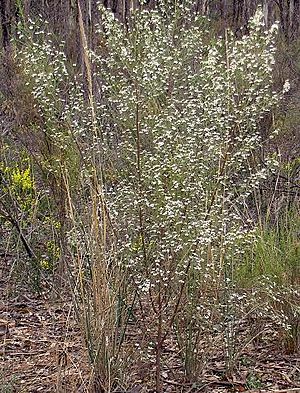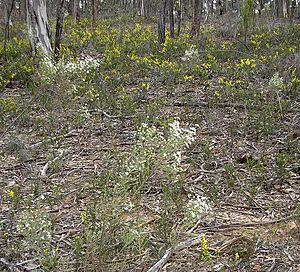Cypress daisy-bush facts for kids
Quick facts for kids Cypress daisy-bush |
|
|---|---|
 |
|
| Plant growing in the Muckleford Forest, Victoria, Australia. | |
| Scientific classification | |
| Kingdom: | |
| (unranked): | |
| (unranked): | |
| (unranked): | |
| Order: | |
| Family: | |
| Tribe: |
Astereae
|
| Genus: |
Olearia
|
| Species: |
O. teretifolia
|
| Binomial name | |
| Olearia teretifolia |
|
| Synonyms | |
|
Eurybia teretifolia Sond. |
|
Olearia teretifolia, often called the cypress daisy-bush, is a special plant from Australia. It's a type of shrub that belongs to the Olearia group. This group is famous for its many different kinds of daisy-like plants.
Contents
All About the Cypress Daisy-Bush
What Does the Cypress Daisy-Bush Look Like?
The cypress daisy-bush is a light and open shrub. It can grow up to about 1.5 meters (that's about 5 feet) tall. Its leaves are quite small, like little rods, only about 6 millimeters long.
In late winter and spring, usually from August to October, this bush gets covered in pretty white flowers. These flowers look like tiny daisies and are about 6 millimeters across. Imagine a bush full of small, white stars!
Where Does the Cypress Daisy-Bush Grow?
You can usually find the cypress daisy-bush growing in special forests in Australia. These are called Box-Ironbark forests. It lives in areas stretching from South Australia all the way across Victoria.
Growing Your Own Cypress Daisy-Bush
If you want to grow a cypress daisy-bush, it's pretty easy! After it finishes flowering, you can trim it. This helps the bush grow into a nice, full shape. It's also a tough plant because it can handle cold weather and frost.
How the Cypress Daisy-Bush Got Its Name
Scientists give plants special names so everyone knows exactly which plant they are talking about. The cypress daisy-bush got its first scientific description in 1853. A German botanist named Otto Wilhelm Sonder studied plants found in the Mount Lofty Ranges and gave it the name Eurybia tertifolia.
Later, in 1865, its name was changed to Aster teretifolius. Finally, in 1867, a botanist from Victoria, Ferdinand von Mueller, gave it the name we use today: Olearia teretifolia.


